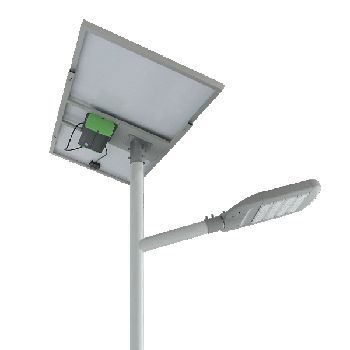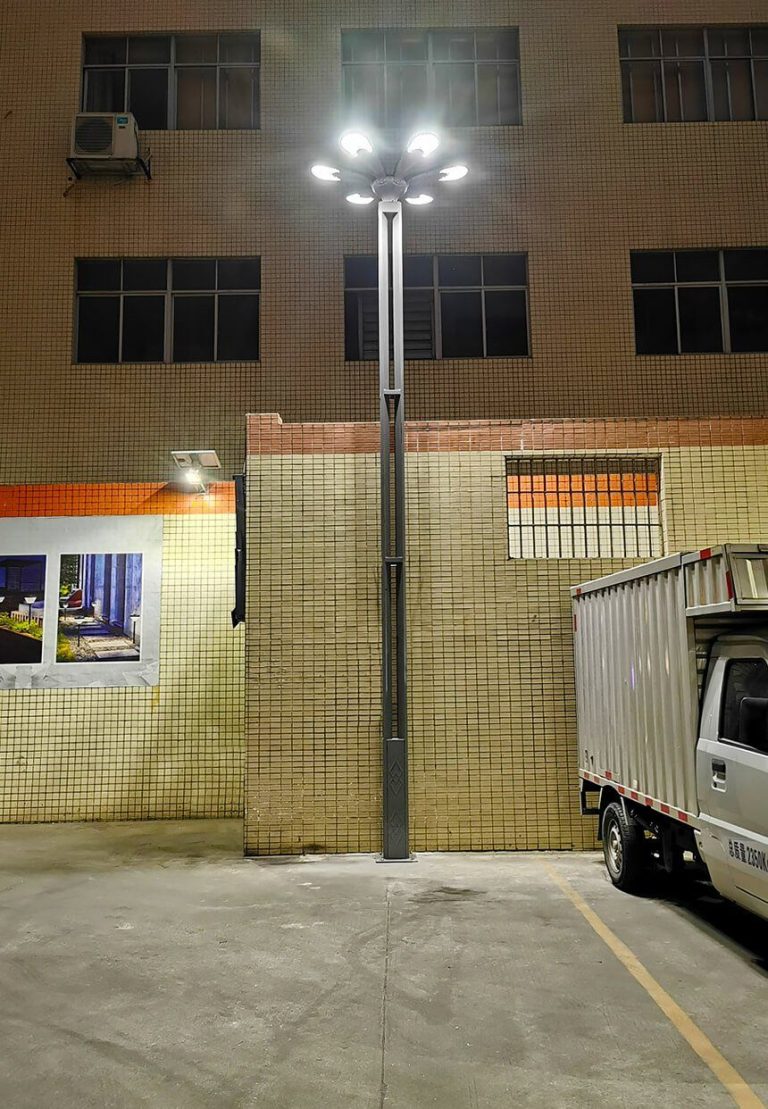Table of Contents
Maximizing Energy Efficiency: Affordable Techniques for Solar Street Luminaire
As concerns over climate change and energy sustainability continue to grow, the demand for renewable energy sources, such as solar power, has increased significantly. Solar street lighting systems, in particular, have gained popularity as a cost-effective and environmentally friendly solution for illuminating streets and public spaces. However, one common challenge faced by many communities is the affordability of such systems. In response to this challenge, manufacturers have developed innovative solutions, such as the affordable split-type solar-powered street lighting fixture.
These split-type solar street lighting fixtures are designed to maximize energy efficiency while remaining cost-effective. Unlike traditional solar street lights, which consist of a single unit containing both the solar panel and the light fixture, split-type fixtures separate these components into two distinct parts. This design allows for greater flexibility in installation and maintenance, as well as improved performance in varying environmental conditions.
One of the key advantages of split-type solar street lighting fixtures is their ability to optimize solar energy capture. By separating the solar panel from the light fixture, manufacturers can position the panel in the most optimal location to receive maximum sunlight exposure throughout the day. This ensures that the solar panel can efficiently convert sunlight into electricity to power the light fixture during the night.
Furthermore, split-type fixtures often feature adjustable solar panels, allowing for easy customization based on the specific requirements of the installation site. This flexibility is particularly beneficial in areas with limited sunlight or shading from nearby structures, as it enables the solar panel to be positioned for optimal performance.
In addition to maximizing energy capture, split-type solar street lighting fixtures also prioritize energy conservation. Advanced LED technology is commonly integrated into these fixtures, providing bright and reliable illumination while consuming minimal energy. LED lights are highly efficient and have a long lifespan, reducing the need for frequent replacements and maintenance.
Moreover, many split-type fixtures are equipped with intelligent lighting control systems, such as motion sensors and dimming capabilities. These features allow the lights to adjust their brightness levels based on surrounding conditions, further reducing energy consumption and enhancing overall efficiency.
The affordability of split-type solar street lighting fixtures is another significant factor driving their widespread adoption. By separating the components and utilizing cost-effective materials and manufacturing processes, manufacturers are able to offer these fixtures at competitive prices without compromising quality or performance. This makes solar street lighting more accessible to communities with limited budgets, enabling them to reap the benefits of renewable energy while reducing their reliance on traditional grid-powered lighting solutions.
In conclusion, split-type solar street lighting fixtures represent a practical and affordable solution for maximizing energy efficiency in outdoor lighting applications. By optimizing solar energy capture, prioritizing energy conservation, and offering competitive pricing, these fixtures address the challenges of affordability while delivering reliable and sustainable illumination for streets and public spaces. As the demand for renewable energy continues to grow, split-type solar street lighting fixtures are poised to play a crucial role in achieving a more sustainable and environmentally friendly future.
The Future of Street Lighting: Affordable Split-Type Solar-Powered Fixtures
As urbanization accelerates and cities expand, the demand for efficient and sustainable street lighting solutions has never been greater. Traditional street lighting systems, reliant on grid electricity, are not only costly to install and maintain but also contribute significantly to carbon emissions. In response to these challenges, the development of affordable split-type solar-powered street lighting fixtures represents a significant stride towards a more sustainable future for urban lighting infrastructure.
One of the primary advantages of split-type solar-powered street lighting fixtures is their affordability. Unlike integrated solar streetlights that come as a single unit, split-type fixtures separate the solar panel, battery, and LED light, making them more cost-effective to manufacture and install. This cost-saving aspect is crucial, especially for municipalities and communities with limited budgets for infrastructure development.
Moreover, the modular design of split-type solar-powered fixtures enhances flexibility and scalability. Municipalities can easily adjust the number of fixtures based on the specific lighting needs of different areas within the city. Whether illuminating main thoroughfares, residential streets, or public parks, the adaptability of split-type fixtures ensures optimal lighting coverage while minimizing unnecessary energy consumption.
Another significant advantage of split-type solar-powered street lighting fixtures is their reduced environmental impact. By harnessing energy from the sun, these fixtures operate entirely off-grid, eliminating reliance on fossil fuels and reducing carbon emissions. This not only contributes to combating climate change but also helps to mitigate the environmental footprint of urban infrastructure.
Furthermore, the durability and reliability of split-type solar-powered fixtures make them an attractive long-term investment. Constructed with high-quality materials and advanced technology, these fixtures are designed to withstand harsh weather conditions and require minimal maintenance. This ensures uninterrupted lighting service for years to come, enhancing safety and security in urban areas.
In addition to their environmental and economic benefits, split-type solar-powered street lighting fixtures also offer improved safety and security for communities. Well-lit streets deter crime and enhance visibility, reducing the risk of accidents and promoting a sense of safety among residents and pedestrians. This is particularly important in areas where access to reliable electricity infrastructure is limited or nonexistent.
The integration of smart technology further enhances the efficiency and effectiveness of split-type solar-powered street lighting fixtures. By incorporating features such as motion sensors, dimming capabilities, and remote monitoring systems, municipalities can optimize energy usage and enhance overall performance. This not only reduces operating costs but also enables proactive maintenance and troubleshooting, ensuring continuous functionality of the lighting infrastructure.
Looking ahead, the widespread adoption of affordable split-type solar-powered street lighting fixtures holds immense promise for the future of urban lighting. As advancements in technology continue to drive down costs and improve efficiency, these fixtures are poised to become the standard for sustainable street lighting worldwide. By embracing innovation and prioritizing sustainability, cities can create brighter, safer, and more resilient urban environments for generations to come.
In conclusion, affordable split-type solar-powered street lighting fixtures represent a transformative solution to the challenges facing urban lighting infrastructure. With their cost-effectiveness, flexibility, and environmental benefits, these fixtures offer a sustainable alternative to traditional grid-based lighting systems. By investing in innovative solutions and embracing renewable energy, cities can illuminate the path towards a brighter and more sustainable future.
Budget-Friendly Solutions: Enhancing Urban Spaces with Affordable Solar Street Lighting
As urban areas continue to expand, the need for efficient and sustainable lighting solutions becomes increasingly pressing. Street lighting plays a crucial role in enhancing safety, security, and aesthetics within urban spaces. However, traditional street lighting systems often come with high installation and operational costs, making them inaccessible for many communities, particularly those with limited budgets. In response to this challenge, the development of affordable solar street luminaires and split-type solar-powered street lighting fixtures has emerged as a promising solution.
| Nr. | Name |
| 1 | Integrated Solar Street Light |
The integration of solar technology into street lighting offers numerous benefits, including reduced energy consumption, lower operating costs, and decreased carbon emissions. By harnessing the power of the sun, these lighting systems provide a sustainable alternative to conventional grid-powered luminaires. Moreover, their off-grid nature makes them particularly well-suited for remote or off-grid locations where access to electricity infrastructure may be limited or unreliable.

One of the key advantages of affordable solar street lighting solutions is their cost-effectiveness. Unlike traditional lighting systems that rely on grid electricity, solar street luminaires operate independently, eliminating the need for costly infrastructure such as underground wiring and electrical connections. This significantly reduces installation expenses and makes solar lighting more accessible to communities with limited financial resources.
Additionally, split-type solar-powered street lighting fixtures offer enhanced flexibility and scalability compared to traditional integrated systems. With a separate solar panel and light fixture, these modular designs allow for easier installation and maintenance, as components can be installed and serviced independently. This not only reduces labor and maintenance costs but also extends the lifespan of the lighting system, resulting in long-term savings for municipalities and local governments.
Furthermore, affordable solar street lighting solutions contribute to the sustainability and resilience of urban infrastructure. By reducing dependence on fossil fuels and centralized power grids, these systems help mitigate the environmental impact of street lighting, leading to cleaner air and reduced carbon emissions. Moreover, their decentralized nature enhances energy security and resilience by diversifying energy sources and reducing vulnerability to grid outages and disruptions.
In addition to their economic and environmental benefits, affordable solar street lighting solutions also have positive social impacts. Improved lighting in public spaces enhances safety and security, particularly in high-crime areas or areas with limited access to lighting. Well-lit streets not only deter crime but also promote community cohesion and social interaction, contributing to overall quality of life in urban areas.
Transitioning to affordable solar street lighting represents a significant opportunity for municipalities, businesses, and communities to achieve their sustainability goals while simultaneously addressing budget constraints. By investing in solar-powered lighting solutions, cities can reduce energy costs, enhance resilience, and create safer, more vibrant urban environments for residents and visitors alike.
In conclusion, affordable solar street luminaires and split-type solar-powered street lighting fixtures offer a compelling solution to the challenges of urban lighting. With their cost-effectiveness, sustainability, and social benefits, these innovative lighting systems have the potential to transform urban spaces and improve quality of life for communities around the world. As the demand for efficient and sustainable lighting continues to grow, investing in affordable solar street lighting solutions represents a forward-thinking approach to enhancing urban infrastructure.






